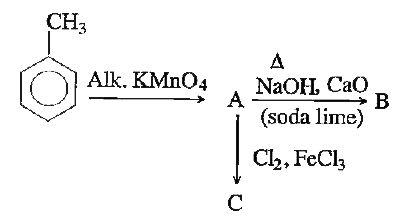
The products (A), (B), and (c ) are:
A
a.
B
b.
C
c.
D
d.
Video Solution
Text Solution
The correct Answer is:B
(i) (H2+Ni) converts (-CHO) group to (−CH2OH) group. (ii) (H2+Ni) at high pressure also reduces double bond of benzene ring along with reduction of (−CHO) group to (−CH2OH) group. (iii) Birch reduction (Na+liq.NH3+C2H5OH) reduces one doule bond of benzene ring to give product with isolated double bond in which EWG (in problem (−CHO) group) ends up allylic to both double bonds. So the answer is (b).
|
Topper's Solved these Questions
- REDUCTION AND OXIDATION REACTION OF ORGANIC COMPOUNDSBOOK - CENGAGE CHEMISTRY ENGLISHCHAPTER - REDUCTION AND OXIDATION REACTION OF ORGANIC COMPOUNDSEXERCISE - Exercise (Assertion And Reasoning)
10 Videos
- REDUCTION AND OXIDATION REACTION OF ORGANIC COMPOUNDSBOOK - CENGAGE CHEMISTRY ENGLISHCHAPTER - REDUCTION AND OXIDATION REACTION OF ORGANIC COMPOUNDSEXERCISE - Exercise Archives (Subjective)
26 Videos
- REDUCTION AND OXIDATION REACTION OF ORGANIC COMPOUNDSBOOK - CENGAGE CHEMISTRY ENGLISHCHAPTER - REDUCTION AND OXIDATION REACTION OF ORGANIC COMPOUNDSEXERCISE - Exercise (Multiple Correct)
35 Videos
- QUALITATIVE INORGANIC SALT ANALYSISBOOK - CENGAGE CHEMISTRY ENGLISHCHAPTER - QUALITATIVE INORGANIC SALT ANALYSISEXERCISE - Viva Voce Questions And Part-C (Analysis Of Cations)
42 Videos
- SOLID STATEBOOK - CENGAGE CHEMISTRY ENGLISHCHAPTER - SOLID STATEEXERCISE - Ex 1.2 (Objective)
9 Videos
Similar Questions
Knowledge Check
The relative reactivity of 1∘,2∘and3∘ hydrogenes in clorination reaction has been found to be 1:3.8:5. In the reaction,

The ratio of the amount of the product (A), (B), (C) and (D) are expected to be :A1:3.8:5:1B3:7.6:5:6C3:7.6:5:3D1:7.6:5:1Consider the following sequence of reactions.
C6H6+CH3CH=CH2H3PO4−−−−−−→heatA1.O2.heat−−−−−−−−−→2.H3O+,heatB+C
The products (B) and (C) are :Abenzaldehyde and acetaldehydeBbenzoic acid and acetic acidCphenol and propionaldehydeDphenol and acetone
Identify the products (A), (B) and ('C').
C2H4HBr−−→(A)Hydrolysis−−−−−→(B)Na2CO3−−−−→I2(C)
View SolutionWrite structures of the products A, B,C,D and E in the following scheme.

View SolutionExplain the formation of products (B), (C), and (D) in the following reaction.

View SolutionPredict the major products (A) , (B) & (C )

View Solution(i) Identity the products A,B and C:
 .
.
(ii) Starting with Grignard.s reagent, how will you prepare propanoic acid ?
(iii) Give balanced equation for the following name reaction : Kolbe.s electrolytic reaction.
View SolutionIdentify the products A, B and C:

View Solution


